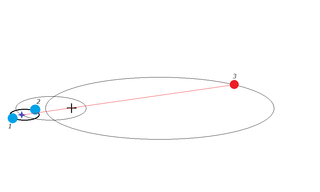EZ Aquarii
|
Multiple star EZ Aquarii |
|||||||
|---|---|---|---|---|---|---|---|

|
|||||||
| Model of a triple star system in which the binary system (1-2) rotates with the third body (3) around the common barycentre . | |||||||
| AladinLite | |||||||
|
Observation dates equinox : J2000.0 , epoch : J2000.0 |
|||||||
| Constellation | Aquarius | ||||||
| Right ascension | 22 h 38 m 33.57 s | ||||||
| declination | -15 ° 17 ′ 59.8 ″ | ||||||
| Apparent brightness | 12.87 mag | ||||||
| Typing | |||||||
| B − V color index | 1.95 | ||||||
| U − B color index | 1.43 | ||||||
| R − I index | 3.44 | ||||||
| Spectral class | M5V B | ||||||
| Variable star type | UV + BY | ||||||
| Astrometry | |||||||
| Radial velocity | (−60.0) km / s | ||||||
| parallax | (293.6 ± 0.9) mas | ||||||
| distance | (11.1 ± 0.1) ly (3.40 ± 0.04) pc |
||||||
| Proper movement | |||||||
| Rec. Share: | (2314 ± 8) mas / a | ||||||
| Dec. portion: | (2295 ± 8) mas / a | ||||||
| Physical Properties | |||||||
| Dimensions | 0.12 / 0.11 / 0.09 M ☉ | ||||||
|
Other names and catalog entries |
|||||||
|
|||||||
EZ Aquarii also Luyten 789-6 or Gliese 866 is a star system that consists of three red dwarfs of the spectral class M and is therefore one of the BY-Draconis stars . It is approximately 11.1 light years (3.4 pc ) from our solar system and is located in the constellation Aquarius .
System structure
The pair EZ Aquarii AC forms a spectroscopic binary system with a period of 3.8 days and a distance of 0.03 AU . EZ Aquarii AC shares a common orbit with EZ Aquarii B, with a duration of 823 days. The A and B components both emit X-rays.
observation
The star with the number 866 in the Gliese catalog was considered a single star for thirty years. In 1986, astronomers at the Max Planck Institute for Astronomy (MPIA) discovered a companion with the help of high-resolution speckle interferometry at a distance of only 0.4 arc seconds from the main star. French astronomers discovered a third, previously unknown companion star during further spectroscopic examinations of GJ 866 in 1999.
The high self-movement of EZ Aquarii was discovered by Willem Jacob Luyten . All three stars could belong to the class of flare stars , since their masses are in the vicinity of the lower limit value for hydrogen fusion of at least 0.08 M ⊙ or 83 Jupiter masses , and their core heat can only be transported by convection .
By combining data sets, the individual stellar masses could be determined with an accuracy of ≈ 1%.
| component | Mass in M ⊙ |
|---|---|
| A. | 0.1187 ± 0.0011 |
| B. | 0.1145 ± 0.0012 |
| C. | 0.0930 ± 0.0008 |
EZ Aquarii C is the weakest member of the system, and the only star with a dynamically determined mass that is safely below 0.1 M ⊙ .
The configuration of the inner binary pair could allow an orbiting planet to orbit near its habitable zone . EZ Aquarii is approaching our solar system and will be at a minimum distance of about 8.2 light years (2.5 pc ) from the Sun in approximately 32,300 years . The nearest neighbor, Lacaille 9352, is about 4.1 light years from EZ Aquarii.
Individual evidence
- ↑ a b c d e f g h i SIMBAD : EZ Aqr. Retrieved September 23, 2019 .
- ↑ a b VSX: EZ Aqr. Retrieved September 23, 2019 .
- ↑ a b c X. Delfosse, et al .: Accurate masses of very low mass stars: II The very low mass triple system Gl 866 . In: Astronomy & Astrophysics, 350: L39-L42 . September 23, 1999. arxiv : astro-ph / 9909409 .
- ↑ Schmitt, JHMM, et al .: An Einstein Observatory X-ray survey of main-sequence stars with shallow convection zones . In: Astrophysical Journal, Vol. 290, p. 307-320 (1985) . March 1, 1985. bibcode : 1985ApJ ... 290..307S . doi : 10.1086 / 162986 .
- ^ Max Planck Institute for Astronomy, Annual Report 1999. In: Max Planck Institute for Astronomy, Heidelberg. 2001, accessed February 12, 2020 .
- ^ EA Popova, et al .: On possible circumbinary configurations of the planetary systems of α Centauri and EZ Aquarii . In: Astronomy Letters, April 2016, Volume 42, Issue 4, pp 260–267 . May 12, 2016. bibcode : 2016AstL ... 42..260P . doi : 10.1134 / S106377371604006X .
- ↑ VV Bobylev: Stars outside the Hipparcos list closely encountering the solar system . In: Astronomy Letters, November 2010, Volume 36, Issue 11, pp 816–822 . October 19, 2010. arxiv : 1009.4856 . bibcode : 2010AstL ... 36..816B . doi : 10.1134 / S1063773710110071 .
- ^ EZ Aquarii 3. In: Sol Company, solstation.com. 2011, accessed February 11, 2020 .